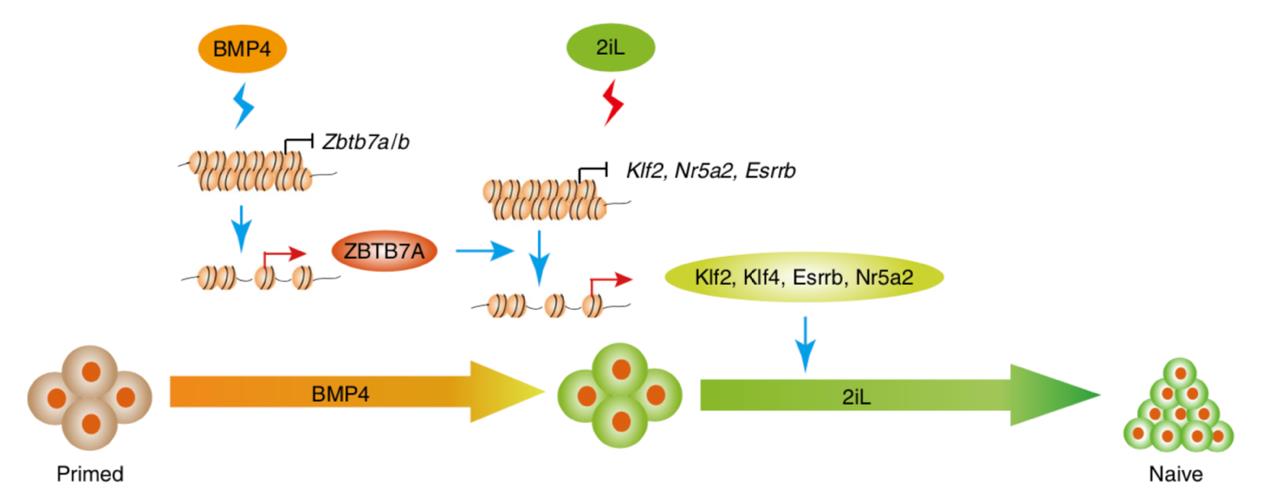Novel system reveals the mechanisms of pluripotency transition
Source:GIBH | Release time:2020-05-13
Source:GIBH | Release time:2020-05-13 | 【Print】 【Close】
The Chinese scientists reported their success in establishing a novel and efficient non-integrated mouse Primed pluripotency to Naive pluripotency Transition (PNT) system and elaborating the new mechanisms underlying the PNT process. The new study was published online in the journal Nature Cell Biology with the title “BMP4 resets mouse epiblast stem cells to naive pluripotency through ZBTB7A/B-mediated chromatin remodeling” on May 11, 2020.
Cell reprogramming and cell fate transition are determined by sophisticated and complex signals transduction and epigenetic regulation. The underlying mechanism and working models for these processes are core issues in the field of cell biology. Mouse embryonic stem cells exist in two unique pluripotent states, Naive state (ESCs, corresponding to pre-implantation embryo 3.5 dpc) and Primed state (EpiSCs, corresponding to post-implantation embryo 5.5-6.5dpc). Primed to naive transition (PNT) represents the reverse of the embryonic development stage from post-implantation to pre-implantation, which needed to overcome some important epigenetic barriers. In the previous reports, PNT usually required the infection of transcription factors by viral vector, which is cumbersome in operation and low in efficiency, hampering its widely application in the field. In addition, the underlining mechanisms for PNT remain to be further clarified.
To address the above issues, the researchers first screened a serious of growth factors and found that BMP4 was capable to induce PNT in mice. Furthermore, by screening a compound library, the researchers identified two small molecule inhibitors, EPZ6438, an EZH2 inhibitor and EPZ5676, a DOT1L inhibitor, could improve PNT efficiency synergistically. Based on these findings, the researchers finally established a PNT induction system with more than 80% efficiency within 8 days. Importantly, the withdrawal of the BMP signal will totally abolish the PNT process, thus they termed this newly established PNT system as BiPNT (BMP induced PNT).
By using RNA-seq and ATAC-seq (chromatin transposase accessibility sequencing), the researchers depicted the chromatin accessibility dynamics during BiPNT, and further prove that, BMP4, the most critical diver factor in BiPNT, inhibited the opening of chromatin loci of differentiation related genes and promoted the opening of chromatin loci of naive pluripotent related genes. Importantly, for the first time, the researchers identified transcription factors Zbtb7a and Zbtb7b, as novel targets of BMP4, could regulate PNT by affecting chromatin remodeling. ChIP-seq experiment further proved that Zbtb7a directly activates the expression of naive pluripotency genes such as Esrrb, Klf2 and Nr5a2, by binding to the upstream regulate elements in the chromatin, thus regulates the occurrence of PNT.
This study greatly improved the PNT transition technic and revealed novel mechanisms for understanding the PNT process. The BiPNT system provides a wonderful paradigm for studying the mechanism of how extracellular signal mediated cell fate transition. In addition, this study offered a valuable reference for the acquisition of naive human embryonic stem cells.
The research team includes groups led by Dr. PEI Duanqing and Dr. LIU Jing from Guangzhou Institute of Biomedicine and Health, Chinese Academy of Sciences (GIBH, CAS). Doctoral graduate students YU Shengyong and ZHOU Chunhua, Dr. CAO Shangtao, and Dr. HE Jiangping made major contributions to this work. The research was supported by grants from The National Key Research and Development Program of China; National Natural Science Foundation of China; Key Research & Development Program of Guangzhou Regenerative Medicine and Health Guangdong Laboratory and is partly supported by Fountain-Valley Life Sciences Fund of University of Chinese Academy of Sciences Education Foundation.

A model for BMP4-induced PNT through ZBTB7A/B.(Image By Liu Jing's group)
Contact:
LIU Jing, Ph.D Principle Investigator
Guangzhou Institute of Biomedicine and Health (GIBH), Chinese Academy of Sciences
E-mail: liu_jing@gibh.ac.cn
| Download the attachment: |
